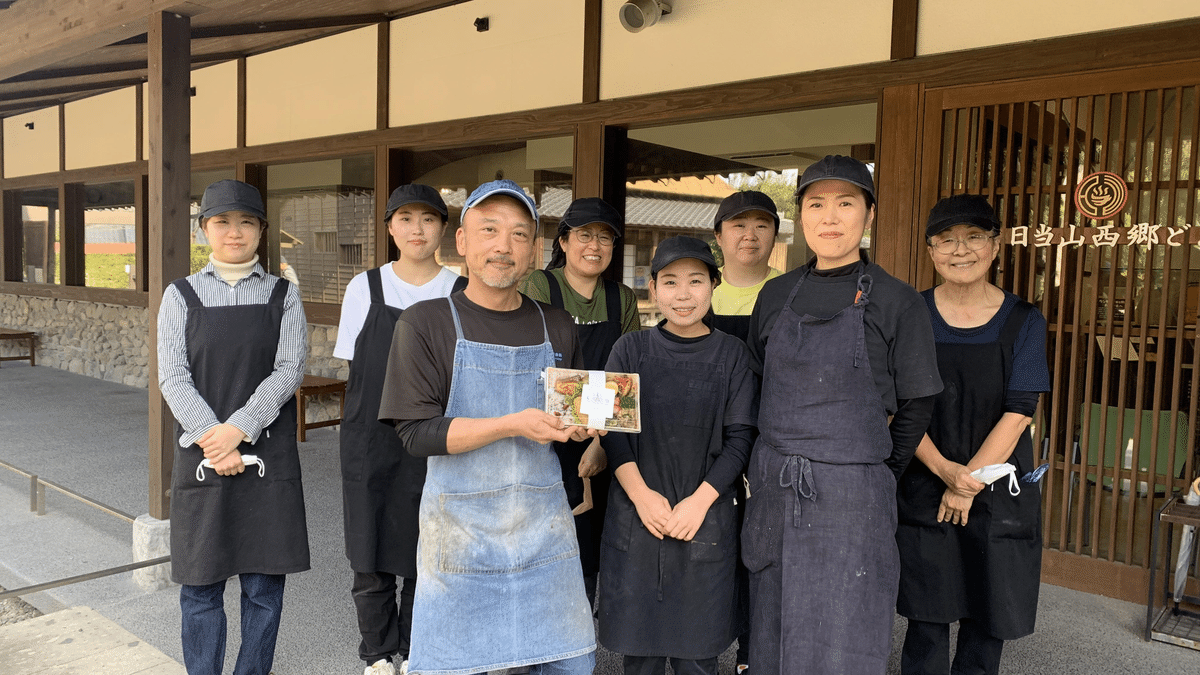
地産地消率100%のお弁当 Circular Design Week 2023

12月2日、3日の2日間に渡り開催されたCircular Design Week 2023 カンファレンスのお弁当を、日当山無垢食堂が担当させていただきました。
11カ国からもの参加者の皆さんが、どなたも「おいしい」「おいしい」と食べてくださり、とても嬉しく思います。
HINATAYAMA MUKU SHOKUDO was in charge of the bento boxes for the Circular Design Week 2023 conference held on December 2 and 3.
We are very happy that all the participants from 11 different countries enjoyed our bentos.
あたりまえだけど、現代ではあたりまえでなくなってしまったこと
Things that are obvious, but are no longer obvious today
日当山無垢食堂のレストランやお弁当で使う材料はそのほとんどが霧島の顔の見える農家さんから購入させていただいているもの。霧島で調達できなかったものは基本的には鹿児島県産のものを使わせていただいています。
また、たとえば今の時期にトマトやきゅうり、ピーマンなどの旬ではない野菜は使いません。
40−50年前には、あたりまえ(というか、それしか選択肢がなかった)だった地元の旬のものを食べるという簡単なことが、なぜか今では「難しいこと」になってしまいました。
スーパーに行けば、季節に関わらず基本的にどんな農産物でも手に入りますし、そのために場合によっては地球の裏側から食糧が運ばれています。
Most of the ingredients used in our restaurant are purchased from farmers in Kirishima. If we are unable to get something from Kirishima, we basically buy products from Kagoshima Prefecture.
We also do not use vegetables that are not in season, like tomatoes, cucumbers, or peppers at this time of year, for example.
Somehow the simple matter of eating local, in-season produce, which was the norm (or rather, the only option) 40-50 years ago, has become a "difficult" thing to manage nowadays.
If you go to the supermarket, you can get basically any agricultural produce you want, regardless of the season, and in some cases food is transported from the other side of the world.

「食料の輸送量(t)」と「輸送距離(km)」をかけあわせた指標を「フードマイレージと呼びますが、現代の日本の食習慣を支えるために、他の国と比べてこれだけたくさん環境への負荷をかけています。
実は私たち消費者が、少し意識を変えるだけで大きな変化を産むことができるのです。
Food Mileage is an index calculated by multiplying the amount of food transported (tons) by the distance transported (kilometers). To support modern Japanese food habits, we put so much more burden on the environment compared to other countries.
In fact, we, as consumers, can make a big difference with just a small change in our awareness.
資源の循環を考える
Considering the Circulation of Resources
ここ霧島市では、生ごみは他の可燃ごみと一緒に焼却処分されています。
しかし、生ゴミってそのほとんどが水分なので、「燃やす」ためには莫大なエネルギーが必要になります。
焼いてしまえばただの灰ですが、資源として活かせば宝になります。
Here in Kirishima City, food waste is burned together with other burnable waste. However, since food wastes are mostly water, huge amounts of energy are required to "burn" them.
If it is burned, it is just ash, but if it is used as a resource, it becomes a treasure.

The food waste that is thrown in is fermented to such a temperature the next day by the power of nature.
私たちは、厨房から出る生ごみを全て発酵させて完熟堆肥を作り、成分検査を行った上で取引先の農家さんにその堆肥を使って農産物を生産していただいています。もちろんそうやってできたお野菜がまた無垢食堂のレストランや物産館に帰ってきます。
We ferment all kitchen waste to make compost, and after testing the composition of the compost, we ask our farmers to use it to produce agricultural products. Of course, the vegetables produced in this way come back to the restaurants and the farmers market of Muku Shokudo.

Farmers say that when they use our compost to grow their crops, the soil becomes soft and fluffy and vegetables grow better!
これからも、あたりまえのことをコツコツと。
We will continue to do the obvious.
体にも、地域にも「おいしい」ものを作るのは、それなりの手間と時間がかかります。しかし、逆を言えば、それだけの手間と時間を惜しんでいては美味しいものは作れないのだと、私たちは思います。
これからも、毎日。あたりまえのことをコツコツと積み重ねていきたいと思います。
It takes a certain amount of time and effort to produce something that is "delicious" for the body, the community, and the environment.
However, in other words, if we spare that much time and effort, we will never be able to produce truly delicious food.
We will continue to do the obvious things day in and day out.
Day1お品書き
・霧島サーモンの河内塩麹焼き
Grilled kirishima salmon with salted rice malt, raised
without medication and using spring water.
・桜島鶏の唐揚げ
Fried Sakurajima chicken
・がね
GANE(means "crab" in Kagoshima dialect) :
Kagoshima's traditional vegetable fritter shaped
like crabs.
・ほうれん草と蓮根の胡麻味噌和え
Organic spinach and lotus root with sesame paste
・紫水菜とマイヤーレモンのマリネ
Marinated purple potherb mustard and meyer lemon
・五色大豆のスパイシーソテー
Spicy sauteed organic five-color soybeans
・卵焼き
Tamagoyaki omelet with cagefree egg
・青パパイヤとビーツのラペ
Green papaya and beet rapé
・新生姜の佃煮
Fresh ginger seasoned with sweet soy sauce
・雑穀米
Multigrain rice
<生産者 producers>
・霧島サーモン Kirishima salmon:ベクトル
株式会社 vector Inc. ・さつまいも Sweet potato:泉さん Mr.Izumi ・ほうれん草 Spinach:エコスマイル Eco-Smile ・蓮根 Lotus root:ニシキプランニング Nishiki planning・紫水菜 purple potherb mustard :shinofattoria ・五色大豆 five-color soybeans:マルマメン工房 Marumamen Kobo ・地鶏の卵 cagefree eggs:カゴシマバンズ Kagoshima banzu ・青パパイヤ green papaya :坂口さん Mr.Sakaguchi・ビーツ beet、新生姜 fresh ginger :竹一農園 Takeichi Farm・お米 rice:西園さん Mr.Nishizono
All ingredients are from Kagoshima Prefecture.
Day2お品書き
・鰤の幽庵焼き
Grilled yellowtail with soy and citrus based sause
・赤芽里芋のコロッケ
Taro croquette
・手前味噌がね
GANE(means "crab" in Kagoshima dialect) :
Vegetable fritter shaped like crabs seasoned with homemade miso
・しいたけのたたき
Shiitake mushrooms deep-fried and marinated in sweet soy sauce
and vinegar
・柿と蕪の辺塚だいだいマリネ
Marinated turnips and persimmons with citrus juice
・大根の豆豉そぼろ餡かけ
Daikon radish with minced soybean paste
・地鶏の煮卵
Boiled egg
・紫キャベツのラペ
Purple Cabbage Rapé
・ローゼルの塩漬け
Salted Roselle
・雑穀米
Multigrain rice
<生産者 producers>
・赤芽里芋 taros:日当山ベジガーデン Hinatayama Vegi garden ・味噌 miso:日当山無垢食堂 Hinatayama muku shokudo ・椎茸 shiitake mushrooms :松下さん Mrs.MAtsushita ・蕪 turnips:いちべじ Ichi Vegi ・大根 daikon radish:竹一農園 Takeichi Farm ・地鶏の卵 cagefree eggs:カゴシマバンズ Kagoshima banzu ・ローゼル Roselle:ここゆ農園 Kokoyu Farm ・お米 rice:西園さん Mr.Nishizono
All ingredients are from Kagoshima Prefecture.
いただいたサポートは、無垢食堂での循環型社会への取組のために使わせていただきます^^
